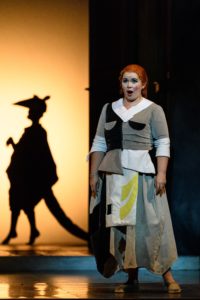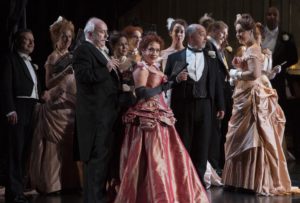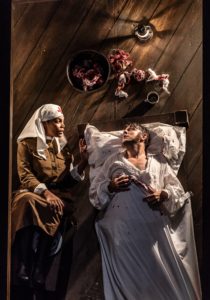It is possible not to be enthused by the directorial style of David Pountney (which Stefanos Lazaridis, his regular collaborator in the times of the English National Opera’s greatest post-war splendour, described as ‘distorted traditionalism’); however, one cannot deny that he is a true opera animal. His love for the queen of musical forms reportedly has a very long history. It all began on a vacation in Berkshire that the five-year-old David spent with his parents among the participants in a summer music camp. One evening, he was crouched down in the corner of an old barn and suddenly, in complete darkness, he heard a solitary voice. The singing of the invisible tenor made an electrifying impression on him, which is no surprise in that what he was hearing in the barn was Florestan’s aria from Act II of Fidelio. For several years, the young Pountney was a trumpeter in the National Youth Orchestra, sang in the choir at St John’s Chapel and, while studying at Cambridge, made friends with Mark Elder and decided to become an opera stage director – among other things, in order not to get in the way of his colleague who had significantly better prospects as a conductor. He entered the world of great fame thanks to a staging of Kát’a Kabanová at the Wexford Festival, and throughout his career, has effectively promoted Janáček’s œuvre. He has directed over a dozen world premières of contemporary operas. He has contributed to the greatness of the Bregenz Festival. He translates libretti from four languages and uses translations in his own productions. In 2011, he became executive and artistic director of the Welsh National Opera, to which he gave a very distinctive profile, often turning to works unknown, neglected or forgotten by the British audience. Last season, the WNO put on 115 performances, most of them on tour; its turnover amounted to over 17 million pounds, and the number of newcomers in the audience exceeded the number of old regular attenders. At the beginning of 2018, the Opera’s board decided not to extend Pountney’s contract. No official reason was given. Suggestions have appeared that the director was imposing too-ambitious repertoire on the theatre, thereby threatening it with bankruptcy in the difficult period after the Brexit referendum, not to mention growing competition from the country house operas and fringe theatres.
There are also opinions circulating to the effect that the formula proposed by Pountney has simply worn out. This year’s seasons were planned, as it were, more cautiously, without the usual watchwords, combining première performances with absolute sure bets that have been scoring triumphs on the world’s opera stages for years. It is difficult for anyone to assign blame for this: a house of this standing is not meant to present just rarities, and superb stagings of the classics should not be pulled from the stage after a few showings. Against the background of propositions from the Scottish Opera and Opera North, however, the WNO’s repertoire comes out quite bland – especially in comparison with several truly outstanding productions from previous years.
La Cenerentola. Tara Erraught (Angelina). Photo: Jane Hobson
Yet again, I was not able to get to Cardiff, instead traveling to Oxford for the autumn season. I will not deny that after months of contact with Regieoper in an unbearably pretentious rendition, I expected a bit of rest at tried-and-true stagings of La Traviata and Rossini’s La Cenerentola. I admit it was with impatience that I awaited Prokofiev’s War and Peace under the direction of Pountney, known for his predilection for operatic ‘Slavdom’. However, first in line was La Cenerentola, a WNO, Houston Grand Opera, Gran Teatre del Liceu and Grand Théatre de Genève co-production revived after 11 years. During that time, the production of two Catalonians – Joan Font and collaborating stage designer Joan Guillén – had managed to win the hearts of audiences at Brussels’ La Monnaie and several opera houses in the United States. And rightly so, for the directing concept of Font – founder of the collective Els Comediants, known to Polish audiences above all for his brilliant setting of the closing ceremony to the Olympic Games in Barcelona – gets to the heart of this masterpiece. Especially in combination with Guillén’s colourful, half-fairytale, half-surreal visual concept derived from commedia dell’arte and other folk theatre traditions, but filtered through the experiences of artists associated with the Ballets Russes, primarily Bakst, Picasso and Miró. Emotion went hand-in-hand with the grotesque; hearty laughter, with moments of reflection. If any charge can be leveled at this staging, it would only be the delightful ubiquity of six dancers dressed as mice who too often ‘stole the show’ from the singers. There were basically no weak points in the cast, starting with the warm and flexible mezzo-soprano of Tara Erraught (Angelina); the stylish, though sharp-timbred Matteo Macchioni (Don Ramiro), the vocally and theatrically phenomenal Giorgio Caoduro (Dandini); the superbly contrasting Aoife Miskelly and Heather Lowe in the roles of the two sisters; the technically superb Fabio Capitanucci (Don Magnifico); and finishing with the impressively cultured phrasing of Wojtek Gierlach (Alidoro). The entirety was conducted by Tomáš Hanus, presently music director of the WNO, who not only disciplined the orchestra and chorus in an ideal manner, but also gave the soloists plenty of room to display their artistry, especially in the gorgeously-blended ensemble numbers.
I took away similar impressions from La Traviata directed by David McVicar, revived 10 years after its première at the Scottish Opera. The production, equally visually tasteful (stage design by Tanya McCallin) and equally subtly led by the conductor (James Southall) as in the case of La Cenerentola, provided yet more evidence of the vitality of traditionally-conceived opera theatre. McVicar moved the action a few decades forward, into scenery taken – as it were – straight from the painting of fin-de-siècle portrait artists, sensual and dark, with a spectre of consumption and neurasthenia lurking in the corners of the salons. He populated this scenery with a crowd of ambiguous characters, internally broken, by turns ruthless and generous, cruel and tormented by guilt feelings, vulgar and angelically pure. This time, the cast was dominated by the gentlemen: the fantastic Roland Wood in the role of Giorgio Germont and the distinctive Kang Wang, with his dark, beautifully rounded tenor, as Alfredo. Anush Hovhannisyan had considerable difficulty getting into the role of Violetta, who from the beginning, in McVicar’s perspective, hides despair under a mask of provocative self-confidence. She revealed the full values of her expressive soprano, rich in dynamic shading, only in Act II, effectively building tension in the shocking dialogue with Alfredo’s father. The final tragedy – played out in a bedroom into which the sun will not shine even after the window curtains have been opened – would have squeezed tears out of a rock. The production team more than satisfied my embarrassing need for melodrama.
La traviata. Philip Lloyd Evans (Marquis d’Obigny), Rebecca Afonwy Jones (Flora), and WNO Chorus. Photo: Betina Skovbro
With regard to War and Peace, however, I had higher expectations, especially bearing in mind the circumstances in which the last of Prokofiev’s operatic masterpieces was written. The composer and his wife Mira Mendelson – co-author of the libretto – performed a true miracle. From Tolstoy’s magnum opus, which the author himself did not want to call a novel and which with each successive volume more and more resembles an expansive philosophical treatise rather than a work of literary fiction, they selected barely a few threads, leaving future audiences to speculate and draw their own conclusions. The work took shape in stages. The first sketches for War and Peace were written at the beginning of the 1930s. The work as a whole went out into the world under the duress of the moment: first in a spontaneous impulse of patriotism evoked by Germany’s attack on the Soviet Union; and later, in the face of stronger and stronger pressure from the Council of Ministers’ Committee on the Arts. At the WNO, the opera was presented in English, but on the basis of a new critical edition of the score prepared by Rita McAllister and Katya Ermolaeva, taking into account most of Prokofiev’s original plans and, as a result, considerably shorter than the final version. Anyone who takes on the staging of War and Peace must realize that this is a non-uniform work, in many ways uneven – one in which references to the great Russian tradition, led by Mussorgsky and Tchaikovsky, are woven into a whole with Prokofiev’s own idiom; sometimes, they fight for the better with national heroics and repulsive models of Stalinist propaganda.
Pountney’s staging – unlike the opera itself – is astoundingly coherent and consistent. And for precisely this reason, it gives the lie to the composer’s plans. Prokofiev tackled a holy book of Russian literature and forged it into something with a completely different quality. Pountney returned to the point of departure and showed the great stereotype of imperial Russia – drawing liberally upon his own productions and upon other people’s pictures that evoke appropriate associations in the mind of the average viewer. He organized the stage space exactly the same way (and with the help of the same stage designer, Robert Innes Hopkins), as in Iain Bell’s opera In Parenthesis of two years earlier. At the time, the half-circular wooden shape symbolized the trenches by the Somme – now it was equally effectively incorporated into the scenery of Russian aristocratic homes and of the battlefield at Borodino. Where the action was taking place, we figured out from projections displayed in the background: in Part II, these were extensive fragments of War and Peace directed by Sergey Bondarchuk. The stage was populated by characters from the pages of the novel, in the military episodes mixed with participants in the Great Patriotic War (in order to introduce the audience to the context in which the opera was written). Everyone was in costumes, as it were, from a historical reenactment show or from the recent BBC miniseries – if Natasha, then in a white dress of gauze; if Kuragin, then in an operetta uniform with gold braids; if Kutuzov, then in a forage cap with a brass telescope in hand.
War and Peace. Lauren Michelle (Natasha) and Jonathan Mc Govern (Andrey) Photo: Clive Barda
If we consider Prokofiev’s War and Peace to be an epic propaganda fresco, praising the unity of the Soviet people in conflict with the foreign invasion, then Pountney executed his task masterfully. If we go back to the sources of inspiration and follow how the composer drew the protagonists by purely musical means – then he suffered an ignominious defeat. The opera was presented with a choice cast; despite this, most of the singers were not able to breathe life into their paper characters. It is difficult to be surprised, given that several soloists had to perform in multiple roles: Simon Bailey, with his light, completely ‘un-Russian’ bass, thrashed back and forth between Balaga, Marshal Davout and the grotesquely-constructed character of Kutuzov. The otherwise splendid David Stout changed costumes from Denisov into Napoleon, along the way portraying Dolokhov and General Rayevsky. American soprano Lauren Michelle in the role of Natasha did not go beyond a ditzy airhead stereotype. Jonathan McGovern was not able to fully show the transformation of his Bolkonsky (and a pity, because he is a sensitive musician with a high, well-handled lyric baritone). Paradoxically, the one who came out best was Mark Le Brocq in the role of Bezukhov – a powerful role written by Prokofiev for spinto tenor, requiring no small ability to reconcile singing with a convincing vision of a good-natured loser who undergoes an amazing metamorphosis over the course of the narrative.
We had to wait almost until the end of the opera for the one and only scene in which Pountney reminded us of his former greatness and, at the same time, got to the heart of the musical message. In the episode of Bolkonsky’s death, I had before my eyes his former productions with the English National Opera. The vertically hanging bed, the skewed lines, the completely disturbed perspective, and in the middle, the feverish Andrey, dying to the ghostly accompaniment of the chorus singing from the wings. And then suddenly it became as if in Tolstoy, whose delirious prose Prokofiev translated excellently into the language of sound: ‘But perhaps it is my shirt on the table,’ thought Prince Andrey, ‘and that’s my legs, and that’s the door, but why this straining and moving and piti-piti-piti and ti-ti and piti-piti-piti… Enough, cease, be still, please.’ Another matter that it was in this scene that the orchestra scaled the heights of interpretation under the baton of Tomáš Hanus – a compliment all the greater that the conductor took in the whole work with an admiration-worthy feel for style, at splendidly-chosen tempi and in strongly contrasting dynamics (separate words of praise for the WNO chorus).
Soon it will be spring; and with it, Pountney’s next, no doubt last staging at this theatre – Verdi’s Un ballo in maschera. Will there again be gold braids, epaulets and bandoliers crossed over chests? Or maybe the director will surprise the audience with something else after all? Maybe he will leave behind an impression that he has not yet said it all?
Translated by: Karol Thornton-Remiszewski



